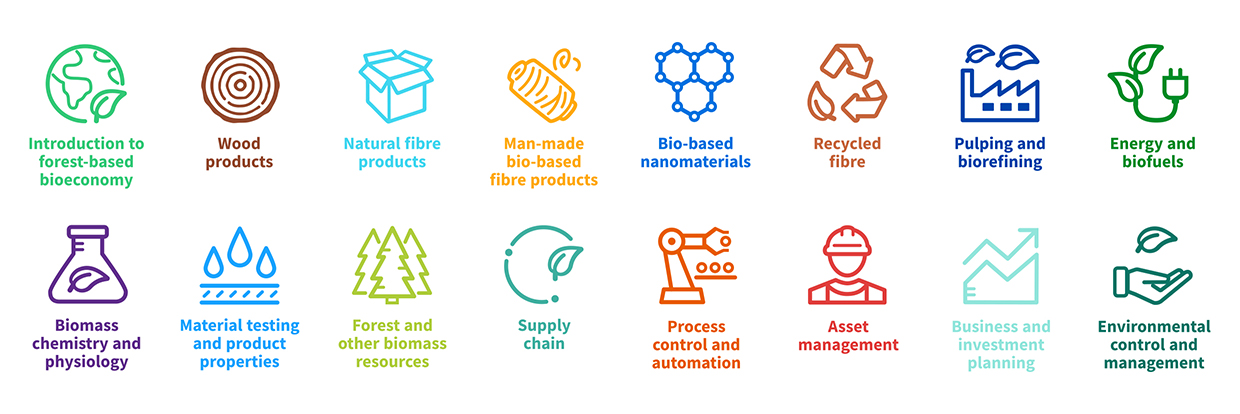A Treasure Trove of Forest Based Bioeconomy
![]() Print this Article | Send to Colleague
Print this Article | Send to Colleague

Text by Outi Rantala
Photos by Patrik Pesonen
Forest has always been an important source of livelihood for Finland. Utilization of industrial side streams and circular economy have emerged alongside traditional forestry and forest industry.
Finnish Forest Products Engineers’ Association, a network for professionals and companies in the forest industry, have built a new digital learning environment in collaboration with universities and leading companies in the field.
The extensive material in the ForestBioFacts learning environment is a true treasure trove, useful for students and professionals alike. Forest industry managers and researchers can also utilize the material, for example as an introduction for new employees.
The learning material is written in English, but the introduction theme, free for all, is available both in Finnish and English. The introduction theme helps in developing bioeconomy skills, for example in lower and upper secondary school, and it has been used as course material for an introductory course on the forest industry for upper secondary school students.
Support for the bioeconomy boom
The ForestBioFacts learning environment includes study modules on 16 themes, for example bio-based nanomaterials. Heli Kangas, Technology Manager at VTT and the editor of this theme, was also responsible for collecting material from other researchers in the field.
“Nanocellulose has been my research topic for more than ten years now.”
At VTT, students play a key role in research.
“Postgraduate students can both examine the topic in depth, and produce topical information for the.jpg) learning environment. VTT’s current aim is to commercialize the results, and in this context, the learning environment also serves business people who are not that familiar with the technical side of things,” Kangas says.
learning environment. VTT’s current aim is to commercialize the results, and in this context, the learning environment also serves business people who are not that familiar with the technical side of things,” Kangas says.
She is excited about the rising interest in the forest industry and the new uses and applications developed for wood.
“Wood is a highly versatile resource. It has been developed into raw material for textiles, innovative packaging materials, and even preparations for treating wounds. It is great that the bioeconomy boom has raised the prestige of the industry and students are interested in this field of study. This digital learning environment, with its almost unlimited information resources, has been created to support this trend.”
Information up-to-date at all times
Timo Jortama, Dr. (Tech.), EMBA, Senior Purchasing Manager, Investments at Stora Enso, has also been part-time visiting lecturer at the University of Oulu for more than 20 years now. He introduces students to fibre technology and always utilizes the latest knowledge and information in teaching.
“We review the industrial fibre product processes, and the skills and knowledge required for them, when working as a young engineer. In spring 2020, the university transferred to remote learning. In view of that, the learning environment was completed at the best possible time,” Jortama says.
He compares the new learning environment with previously used digital learning materials:
“The previous versions were good as well, but this one cuts straight to the point. In addition to the basics, there is in-depth information about the industry, allowing young students or researchers to get a better grip of the topics. The digital dimension allows handling of the topics on a much broader scale than before.”
Jortama finds it important that the learning material describes the forest industry extensively as a business environment as well:
“The previous series of books was comprehensive, but digitalization allows the inclusion of up-to-date international information. For a teacher, this is excellent, because digital material is quick to update. Of course, digital teaching skills are a must for the teacher.”
Jortama has noticed the positive trend of forest bioeconomy, and the social demand for it.
“There is good buzz and a lot going on at the moment. We are developing a new direction for societies to structure their material and energy supply and management. This is hugely significant for the national economy. The students are genuinely willing to learn and interested in using their skills and competence to influence the state of the environment.”
The learning environment is continuously developed further on the basis of feedback collected from users. The ForestBioFacts learning environment, launched in November 2020, has been licensed to over 40 education providers and companies in the field worldwide.
Infobox:
An abundant information package
- ForestBioFacts includes a free introduction to forest bioeconomy, suitable for lower and upper secondary schools.
- The learning environment covers 16 themes throughout the value chain of forest bioeconomy.
- Over 150 experts in the forest bioeconomy sector have contributed to the content production.
- The contents comprise 1,500 articles, 300 videos, a dictionary of 6,000 terms in six languages, and a comprehensive glossary.
Click here to learn more about ForestBioFacts.
.jpg)
Heli Kangas, Technology Manager, responsible for the technology strategy and commercialization of technologies in the research area of biomaterial processing and products at VTT, says that the bioeconomy boom has raised the prestige of the forest-based sector and students’ interest in the field. The digital learning environment, with its huge information resources supports this trend.


